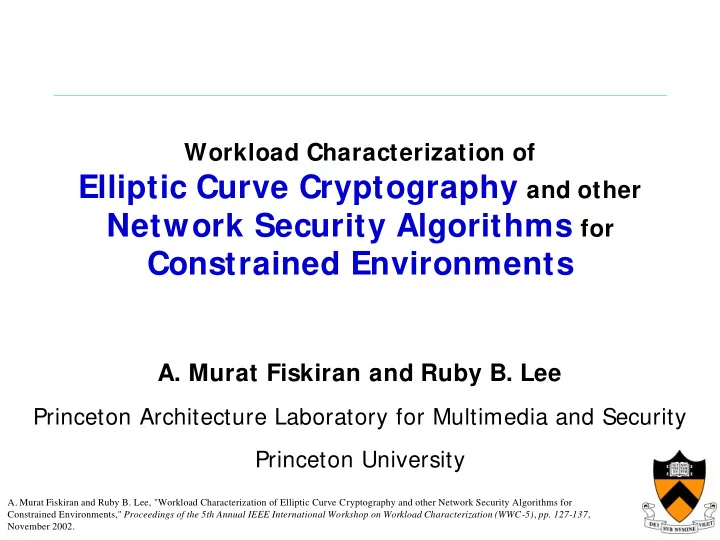

Workload Characterization of Elliptic Curve Cryptography and other Network Security Algorithms for Constrained Environments A. Murat Fiskiran and Ruby B. Lee Princeton Architecture Laboratory for Multimedia and Security Princeton University A. Murat Fiskiran and Ruby B. Lee, "Workload Characterization of Elliptic Curve Cryptography and other Network Security Algorithms for Constrained Environments," Proceedings of the 5th Annual IEEE International Workshop on Workload Characterization (WWC-5) , pp. 127-137 , November 2002.
Need for Security? • Wireless devices: PDAs, multimedia cell phones, tablet PCs … – Public channel = need for cryptography – Limited processing power, memory, power Class Function Key exchange, user authentication, Public-key digital signature Symmetric-key Confidentiality Hash Integrity
Algorithm Set Class Typical key size Examples 1024 – 2048 bits (non-elliptic curve) Diffie-Hellman , Public-key ElGamal, DSA 163 – 233 bits (elliptic curve) Symmetric-key 128 – 256 bits DES, AES Hash N/A SHA, MD5 • Diffie-Hellman is representative of other elliptic-curve algorithms.
Diffie-Hellman on Elliptic Curves • E is an elliptic curve, P = (x,y) is a point on E. Alice Bob Choose a. Choose b. P × a P × b (P × b) × a (P × a) × b Based on elliptic-curve discrete logarithm problem
Point Multiplication • P × a is point multiplication. The result is another point on the elliptic curve. • Computed by a double-and-add chain – No easy way to compute any arbitrary multiple of P. • Example: if a = 13, then: P × 13 = [(2 × P + P) × 2 × 2] + P
Point Doubling and Addition P = ( x,y ) P = ( x 1 ,y 1 ), Q = ( x 2 ,y 2 ) P × 2 = ( x f ,y f ) P + Q = ( x 3 ,y 3 ) y + θ = + y y θ = x 2 1 + x x x 2 1 = θ + θ + 2 = θ + θ + + + x a 2 x x x a f 3 1 2 = θ + + + = + θ + 2 y ( x x ) x y y x ( 1 ) x 3 1 3 3 1 f f 4 addition, 2 multiplication, 9 addition, 2 multiplication, 2 squaring, 1 inversion 1 squaring, 1 inversion
Binary Fields • Coordinates of P= (x,y) come from a field. • Fastest implementations are on binary fields. – Field elements = binary polynomials • Example: P = ( x + 1, x 2 + 1) = (0011,0101) 2
ECC and Polynomial Operations Point doubling Point addition 4 addition, 2 multiplication, 9 addition, 2 multiplication, 2 squaring, 1 inversion 1 squaring, 1 inversion Addition Multiplication Squaring I nversion Shift-and-add Self-multiplication Extended Euclidean XOR Table-lookup Table-lookup Almost I nverse Polynomial multiplier New instructions Orange: basic Green: optimized
Methodology • Algorithms coded and optimized in assembly • 64-bit basic RISC architecture • Simulated using two algorithm sets: basic and optimized • 163-bit and 233-bit keys • Diffie-Hellman, ElGamal, DSA • AES and SHA (for completeness)
Speedup From Optimized Algorithms 20 17.9 16.9 18 16.3 15.3 16 14.5 12.9 14 12 10 8 6 4 1 1 1 1 1 1 2 0 DH-163 ElGamal- DSA-163 DH-233 ElGamal- DSA-233 163 233
Instruction Distribution 100% 80% Other 60% Memory 40% Compute 20% 0% 1a 1b 2a 2b 3a 3b 1a. EC-DHKE basic (1.0) 1b. EC-DHKE optimized (14.5) 2a. EC-ElGamal basic (1.0) 2b. EC-ElGamal optimized (16.9) 3a. EC-DSA basic (1.0) 3b. EC-DSA optimized (15.3)
Pathlength Increase: From 163-bit to 233-bit keys 3 2.8 2.7 2.6 2.6 2.5 2.5 2.2 2 1.5 1 1 1 1 1 1 1 0.5 0 DH-basic ElGamal- DSA-basic DH- ElGamal- DSA- basic optimized optimized optimized
Observations 1. Algorithmic enhancements provide 15× speedup. – Mainly by reducing arithmetic operations (up to 30× ) 2. Memory instructions are as frequent as compute instructions. – Reasons: Function call overhead, long data types – Further speedups possible based on memory optimizations (?) 3. Longer keys result in disproportionately large slowdowns. – Complexity of ECC operations 4. DH and ElGamal have similar distributions. – DSA is different; includes SHA as hash algorithm. 5. Optimized algorithms use little extra memory (< 1kB). 6. A separate multiplier is not needed.
Summary 1. Selection of algorithms suitable for constrained environments: – Elliptic-curve versions of DH, ElGamal, and DSA; AES and SHA 2. Description of operations needed; focus on elliptic-curve and polynomial operations 3. Instruction frequencies 4. Sufficiency of a simple RISC processor
Future Work • Expand algorithm set – Include block ciphers, other signature and hash algorithms • Expand arithmetic operations to – Integers (prime fields) – Different representation of polynomials (different bases) – Different coordinate systems (e.g. projective)
Recommend
More recommend